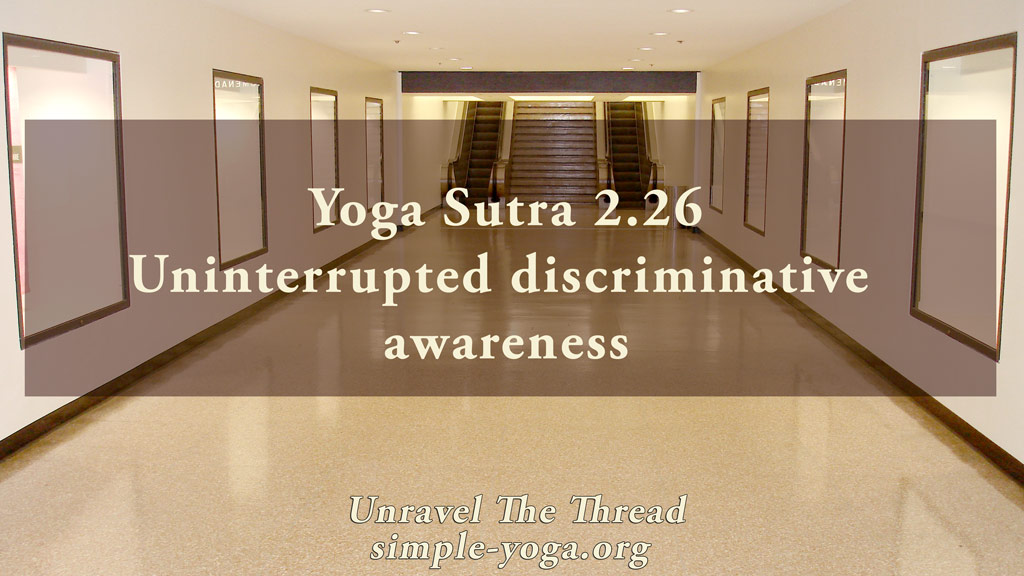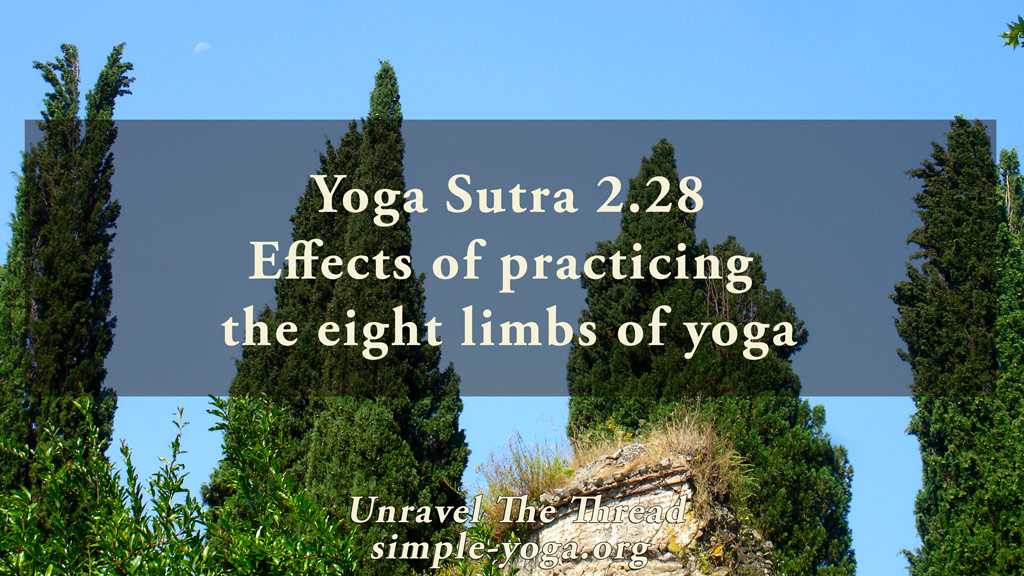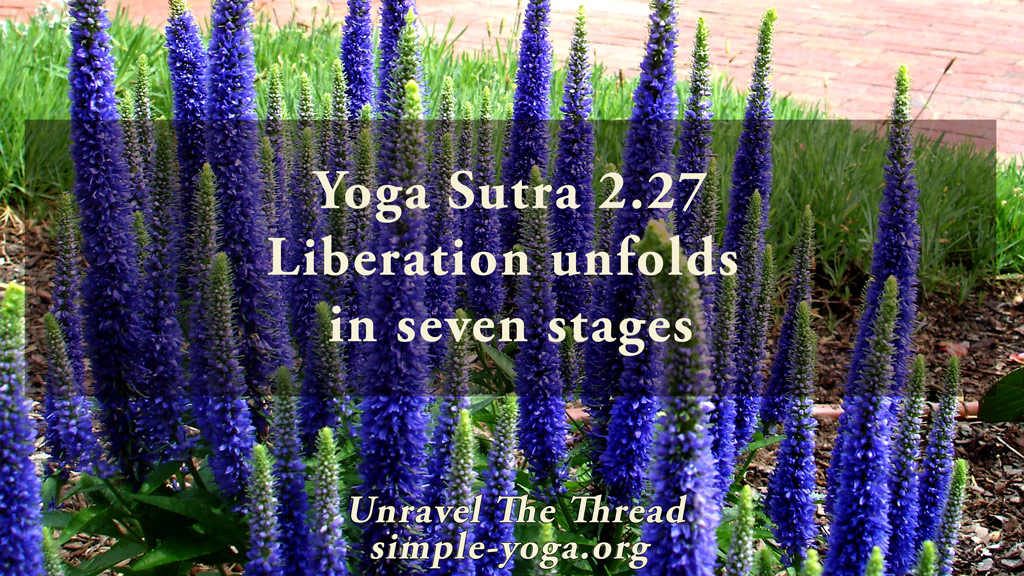
2.26 Uninterrupted discriminative awareness
August 15, 2020
2.28 Effects of practicing the eight limbs of yoga
September 6, 2020
2.26 Uninterrupted discriminative awareness
August 15, 2020
2.28 Effects of practicing the eight limbs of yoga
September 6, 20202.27 Liberation unfolds in seven stages

After presenting uninterrupted discriminative awareness as the means to liberation, Patañjali explains how to get there in this sutra and the rest of this chapter. The seven stages mentioned in this verse are the steps that lead you to full integration (samadhi). Patañjali does not list the individual steps explicitly. However, some commentators on the text believe that the seven steps are the first seven steps included in the set of eight limbs of yoga mentioned in the following verse. On the other hand, it is useful to know that the first complete and thorough commentary on the Yoga Sutra was composed by an author called Vyasa perhaps in the 7th or 8th century CE. (Some scholars, however, state that what we consider Vyasa’s commentary may have been created by Patañjali himself.) To this day, most interpretations of the Yoga Sutra take Vyasa’s perspective and examples as a fundamental companion to the Yoga Sutra. Vyasa’s commentary on this sutra summarizes some of the material presented so far in the complete Yoga Sutra. According to Vyasa the first step is noticing the suffering than can be avoided. The second step is identifying the causes of suffering in order to remove them. Third, those distractions are lessened through establishing inner peace. In the fourth step, an internal climate of clarity and discernment takes hold. As a result, in the fifth step, everything that can be experienced is seen as a pathway to liberation from the restrictions and limitations closing the heart and the mind. Then, in the sixth step, the desire to manipulate the forces of nature ceases. Finally, in the seventh step, the practitioner embodies an effortless harmony between life and awareness.
Liberation is a gradual process that requires acting with enthusiasm, intelligence and humility (yogic action 2.1). Applying yourself with gentle persistence (abhyasa & vairagya 1.12), you grow in sensitivity and learn to regulate your ways of being with more finesse and fluidity. Like in any other learning endeavor, the more you practice something, the easier it is to tune into the subtle aspects of what you are doing. When you try to learn to dance to a specific rhythm, at first it is difficult to understand how the legs, arms and body need to move from one step to the next. Then, the more you practice, the more familiar you become with different ways to make the movements more fluid and easeful. In time, you grow in your ability to match the rhythm of the music. And perhaps, after much practice, it may be possible to move in ways that seem effortless and graceful. This whole process works best when it is an enjoyable journey of learning. Otherwise, it can turn into a source of agitation or self-torture. All processes in nature are gradual. From a seed capable of sprouting to a full grown, mature tree, it takes countless weeks of gradual, often imperceptible, progress facilitated by the appropriate conditions and circumstances. Similarly, for most people, it takes a long time to free themselves from deeply ingrained ways of being. Progress moves according to your capacity and trying to handle more than you can is a sure way to regress.
It is useful to remember the notion of self-regulation, or developing the keen awareness to sense what is appropriate, relevant and beneficial for the moment that you are in. Since each moment is unique, what used to be appropriate may no longer be appropriate, or useful, today. Self-regulation necessitates awareness. To prepare for these steps, you can establish your firm intention to commit to living your life with gracious awareness. Get good at noticing when you are calm and when you are irritated, anxious, upset or bothered. Try to discern the causes of these irritations. Is it possible that your annoyance at somebody’s words may reflect some unfulfilled expectation or assumption on your part? When you get frustrated by something beyond your control, could you find other, more useful mindsets and attitudes? How are you cultivating your ability to be centered and balanced? When you are balanced, is it easier to notice and resolve irritation and discomfort without agitation? Does this seem to help establish a new habit of being centered? Can you appreciate how everything you encounter offers you an opportunity to learn, and to transcend your own limitations and restrictions? Does this attitude change your relationship to yourself, to others, and to the world around you? How does this change your attitude and experiences? You may have noticed that this set of questions follows the steps presented by Vyasa. Along the path towards discriminative awareness, consider if it is helpful to cultivate the qualities of yogic action listed in sutra 2.1: Enthusiasm (tapas), intelligence (svadhyaya) and humility (ishvara pranidhana) . Since it may be a long journey, can the strategy from sutra 1.12, patient persistence (abhyasa) and freedom from attachment (vairagya)be useful? To what extent are the five attitudes from verse 1.20 helpful: trust and confidence (shraddha), vigor (virya), remembrance (smriti), evenness of mind (samadhi) and insight (prajña)? You may also want to verify the sincerity and level of intensity of your commitment (1.21 & 1.22) and their influence on how the process is developing for you.
As usual, one more way of exploring the meaning of this sutra is by chanting it.
You can choose to chant it in its traditional form with some of the words coming together:
2.27 tasya saptadhā prāntabhūmiḥ prajña
तस्य सप्तधा प्रान्तभूमिः प्रज्ञ ॥२७॥
Another option is to chant each word in the sutra individually:
- tasya
- saptadhā
- prānta
- bhūmiḥ
- prajñā
If you prefer, you may listen to the podcast:
Unravel the thread is now available as a book!
If you find Simple-Yoga.org and Unravel the thread useful, consider supporting my labor with a donation, you may also donate using PayPal or Venmo. Thank you!
